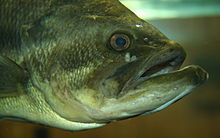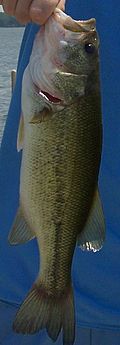Largemouth bass
| Largemouth bass | |
|---|---|
 | |
 | |
Conservation status | |
 Least Concern (IUCN 3.1)[1] | |
Scientific classification | |
| Kingdom: | Animalia |
| Phylum: | Chordata |
| Class: | Actinopterygii |
| Order: | Perciformes |
| Family: | Centrarchidae |
| Genus: | Micropterus |
| Species: | M. salmoides |
Binomial name | |
Micropterus salmoides (Lacépède, 1802)[2] | |
The largemouth bass (Micropterus salmoides) is a freshwater gamefish in the Centrarchidae (sunfish) family, a species of black bass native to North America. It is known by a variety of regional names, such as the widemouth bass, bigmouth bass, black bass, bucketmouth, largies, Potter's fish, Florida bass, Florida largemouth, green bass, Green trout, gilsdorf bass, Oswego bass, southern largemouth and (paradoxically) northern largemouth, LMB.[3] The largemouth bass is the state fish of Georgia, Mississippi, and Indiana, the state freshwater fish of Florida and Alabama, and the state sport fish of Tennessee.
Contents
1 Description
2 Feeding
3 Spawning
4 Angling
5 Invasive species
6 References
7 External links
Description
The largemouth bass is an olive-green to greenish gray fish, marked by a series of dark, sometimes black, blotches forming a jagged horizontal stripe along each flank.[4] The upper jaw (maxilla) of a largemouth bass extends beyond the rear margin of the orbit.[5] In comparison to age, a female bass is larger than a male.[6] The largemouth is the largest of the black basses, reaching a maximum recorded overall length of 29.5 in (75 cm)[7] and a maximum unofficial weight of 25 pounds 1 ounce (11.4 kg).[7] The fish lives 16 years on average.[8]
Feeding
The juvenile largemouth bass consumes mostly small bait fish, scuds, small shrimp, and insects. Adults consume smaller fish (bluegill, banded killifish), shad, snails, crawfish (crayfish), frogs, snakes, salamanders, bats[9] and even small water birds, mammals, and baby alligators.[10] In larger lakes and reservoirs, adult bass occupy deeper water than younger fish, and shift to a diet consisting almost entirely of smaller fish like shad, yellow perch, ciscoes, shiners, and sunfish. It also consumes younger members of larger fish species, such as catfish, trout, walleye, white bass, striped bass, and even smaller black bass. Prey items can be as large as 50% of the bass's body length or larger.
Studies of prey utilization by large mouths show that in weedy waters, bass grow more slowly due to difficulty in acquiring prey. Less weed cover allows bass to more easily find and catch prey, but this consists of more open-water baitfish. With little or no cover, bass can devastate the prey population and starve or be stunted. Fisheries managers must consider these factors when designing regulations for specific bodies of water. Under overhead cover, such as overhanging banks, brush, or submerged structure, such as weedbeds, points, humps, ridges, and drop-offs, the large mouth bass uses it's senses of hearing, sight, vibration, and smell to attack and seize its prey. Adult largemouth are generally apex predators within their habitat, but they are preyed upon by many animals while young.[11]
Notably in the Great Lakes Region, Micropterus salmoides along with many other species of native fish have been known to prey upon the invasive round goby (Neogobius melanostomus). Remains of said fish have been found inside the stomachs of largemouth bass consistently. This feeding habit may impact the ecosystem positively, but more research must be conducted to verify this. Note that it is illegal to use Neogobius melanostomus as bait in the Great Lakes Region.[12]
Spawning

Side view of a living largemouth bass.
Largemouth bass first begin to spawn when they are about a year old.[13] Spawning takes place in the spring season when the water temperature holds steady above 60˚F. In the northern region of the United States, this usually occurs anywhere from late April until early July. In the southern states, this process can begin in March and is usually over by June.[14] Males create nests by moving debris from the bottom of the body of water using their tails. These nests are usually about twice the length of the males, although this can vary.[13] Bass prefer sand or gravel bottoms, but will also use soft bottoms where there is cover for their nest, such as roots or twigs.[15] After finishing the nest, the males swim near the nest looking for a female to mate with. After one is found, the two bass swim around the nest together, turning their bodies so that the eggs and sperm that are being released will come in contact on the way down to the nest. Bass will usually spawn twice per spring, with some spawning three times, although this is not as common. The male will then guard the nest until the eggs hatch, which can take about 2 to 4 days in the southern U.S., and slightly longer in the northern part of the country. Finally, depending on the water temperature, the male will stay with the nest until the infant bass are ready to swim out on their own, which can be about two more weeks after they hatch. After this, the male, female, and newborns will switch to more of a summer mode, in which they then focus more on feeding.[13]
Angling

A Largemouth bass caught by an angler.
Largemouth bass are keenly sought after by anglers and are noted for the excitement of their 'fight,' meaning how vigorously the fish resists being hauled into the boat or onto shore after being hooked. The fish will often become airborne in their effort to throw the hook, but many say that their cousin species, the smallmouth bass, can beat them pound for pound.[16] Anglers most often fish for largemouth bass with lures such as plastic worms (and other plastic baits), jigs, crankbaits, and spinnerbaits. A recent trend is the use of large swimbaits to target trophy bass that often forage on juvenile rainbow trout in California. Fly fishing for largemouth bass may be done using both topwater and worm imitations tied with natural or synthetic materials. Live bait, such as nightcrawlers, minnows, frogs, or crawfish can also be productive. In fact, large golden shiners are a popular live bait used to catch trophy bass, especially when they are sluggish in the heat of summer or in the cold of winter.[17] Largemouth bass usually hang around big patches of weeds and other shallow water cover. These fish are very capable of surviving in a wide variety of climates and waters. They are perhaps, one of North America's most tolerant fish.
The world record largemouth according to IGFA is shared by Manabu Kurita and George W. Perry. Kurita's bass was caught from Lake Biwa in Japan on July 2, 2009 and weighed 10.12 kg (22 lbs 4oz.) Perry's bass was caught June 2, 1932 from Montgomery Lake in Georgia and weighed 10.09 kg (22 lbs 4oz.) This record is shared because the IGFA states a new record must beat the old record by 2 ounces.[18]
Strong cultural pressure among largemouth bass anglers encourages the practice of catch and release, especially the larger specimens, mainly because larger specimens are usually breeding females that contribute heavily to future sport fishing stocks. Largemouth bass, if handled with care, respond well to catch and release. They have a white, slightly mushy meat, lower quality than that of the smallmouth bass, bluegill, yellow perch, crappie or walleye. Small largemouth, 10-14 inches, can be quite delicious when the water temperature is low.
Invasive species
The largemouth bass has been introduced into many other regions and countries due to its popularity as a sport fish. It causes the decline, displacement or extinctions of species in its new habitat through predation and competition,[19] for example in Namibia. They are an invasive species in the Canadian province of New Brunswick, and are a danger to native fish fry.[20] They have also been blamed for the extinction of the Atitlan Grebe, a large waterbird which once inhabited Lake Atitlan, Guatemala.[21] In 2011, researchers found that in streams and rivers in the Iberian Peninsula, juvenile largemouth bass were able to demonstrate trophic plasticity, meaning that they were able to adjust their feeding habits to obtain the necessary amount of energy needed to survive. The ability to do such, allows them to be successful as invasive species in relatively stable aquatic food webs.[22] Similarly, a study done in Japan showed that the introduction of both largemouth bass and bluegill into farm ponds have caused increases in the numbers of benthic organisms, resulting from the predation on fishes, crustaceans, and nymphal odonates by the bass.[23] The largemouth bass has been causing sharp decreases in native fish populations in Japan since 1996, especially in bitterling fish in Lake Izunuma-Uchinuma.[24]
References
^ NatureServe (2013). "Micropterus salmoides". The IUCN Red List of Threatened Species. 2013: e.T61265A18229518. doi:10.2305/IUCN.UK.2013-1.RLTS.T61265A18229518.en. Retrieved 14 January 2018..mw-parser-output cite.citationfont-style:inherit.mw-parser-output qquotes:"""""""'""'".mw-parser-output code.cs1-codecolor:inherit;background:inherit;border:inherit;padding:inherit.mw-parser-output .cs1-lock-free abackground:url("//upload.wikimedia.org/wikipedia/commons/thumb/6/65/Lock-green.svg/9px-Lock-green.svg.png")no-repeat;background-position:right .1em center.mw-parser-output .cs1-lock-limited a,.mw-parser-output .cs1-lock-registration abackground:url("//upload.wikimedia.org/wikipedia/commons/thumb/d/d6/Lock-gray-alt-2.svg/9px-Lock-gray-alt-2.svg.png")no-repeat;background-position:right .1em center.mw-parser-output .cs1-lock-subscription abackground:url("//upload.wikimedia.org/wikipedia/commons/thumb/a/aa/Lock-red-alt-2.svg/9px-Lock-red-alt-2.svg.png")no-repeat;background-position:right .1em center.mw-parser-output .cs1-subscription,.mw-parser-output .cs1-registrationcolor:#555.mw-parser-output .cs1-subscription span,.mw-parser-output .cs1-registration spanborder-bottom:1px dotted;cursor:help.mw-parser-output .cs1-hidden-errordisplay:none;font-size:100%.mw-parser-output .cs1-visible-errorfont-size:100%.mw-parser-output .cs1-subscription,.mw-parser-output .cs1-registration,.mw-parser-output .cs1-formatfont-size:95%.mw-parser-output .cs1-kern-left,.mw-parser-output .cs1-kern-wl-leftpadding-left:0.2em.mw-parser-output .cs1-kern-right,.mw-parser-output .cs1-kern-wl-rightpadding-right:0.2em
^ Froese, Rainer and Pauly, Daniel, eds. (2010). "Micropterus salmoides" in FishBase. February 2010 version.
^ "Black Bass". Florida Fish and Wildlife Conservation Commission: Division of Freshwater Fisheries. Archived from the original on April 23, 2006. Retrieved March 17, 2007.
^ "What Color is Your Largemouth Bass?". takemefishing.org. Retrieved 30 July 2018.
^ [1] Archived January 2, 2011, at the Wayback Machine.
^ [2] Archived November 6, 2014, at the Wayback Machine.
^ ab "Escondido's world-famous bass found dead". San Diego Union-Tribune. Retrieved May 27, 2009.
^ "Largemouth Bass (Micropterus salmoides)". Texas Parks and Wildlife. Retrieved October 3, 2008.
^ Mikula, P. 2015: Fish and amphibians as bat predators. European Journal of Ecology 1 (1): 71-80. doi: 10.1515/eje-2015-0010
^ "Fish vs Alligator". YouTube.com. February 17, 2007. Retrieved May 19, 2015.
^ [3] Archived April 10, 2011, at the Wayback Machine.
^ "Excerpt of Michigan's Natural Resource and Environmental Protection Act" (PDF). Legislature.mi.gov. Retrieved May 19, 2015.
^ abc Davis, Lock, James, Joe (August 1997). "Largemouth Bass: Biology and Life History" (PDF). Southern Regional Aquaculture Center.
^ Whitcomb, Andy (February 28, 2016). "Largemouth Bass Spawning and Fishing Consideration". TakeMeFishing.org.
^ "Fishes Of Wisconsin: Largemouth Bass". Wisconsin Department of Natural Resources. August 31, 2012.
^ [4] Archived November 11, 2013, at the Wayback Machine.
^ "Bass Fishing Tips - Tips on How to Catch a Largemouth Bass". Fishingtipsdepot.com. Retrieved May 19, 2015.
^ "IGFA World Record | All Tackle Records | Bass, largemouth". Wrec.igfa.org. Retrieved May 19, 2015.
^ "issg Database: Impact Information for Micropterus salmoides". www.issg.org. Retrieved January 22, 2016.
^ [5] Archived May 21, 2015, at the Wayback Machine.
^ Roots, Clive (January 1, 2006). Flightless Birds. Greenwood Publishing Group. ISBN 9780313083945.
^ Almeida, David; Almodóvar, Ana; Nicola, Graciela G.; Elvira, Benigno; Grossman, Gary D. (January 1, 2012). "Trophic plasticity of invasive juvenile largemouth bass Micropterus salmoides in Iberian streams". Fisheries Research. 113 (1): 153–158. doi:10.1016/j.fishres.2011.11.002.
^ Maezono, Yasunori; Miyashita, Tadashi (January 1, 2003). "Community-level impacts induced by introduced largemouth bass and bluegill in farm ponds in Japan". Biological Conservation. 109 (1): 111–121. doi:10.1016/S0006-3207(02)00144-1.
^ "Nature Restoration Projects in Japan: Lake Izunuma-Uchinuma" (PDF). Ministry of the Environment. Government of Japan. March 2009. Retrieved January 22, 2016.
External links
 Media related to Micropterus salmoides at Wikimedia Commons
Media related to Micropterus salmoides at Wikimedia Commons Data related to Largemouth bass at Wikispecies
Data related to Largemouth bass at Wikispecies
